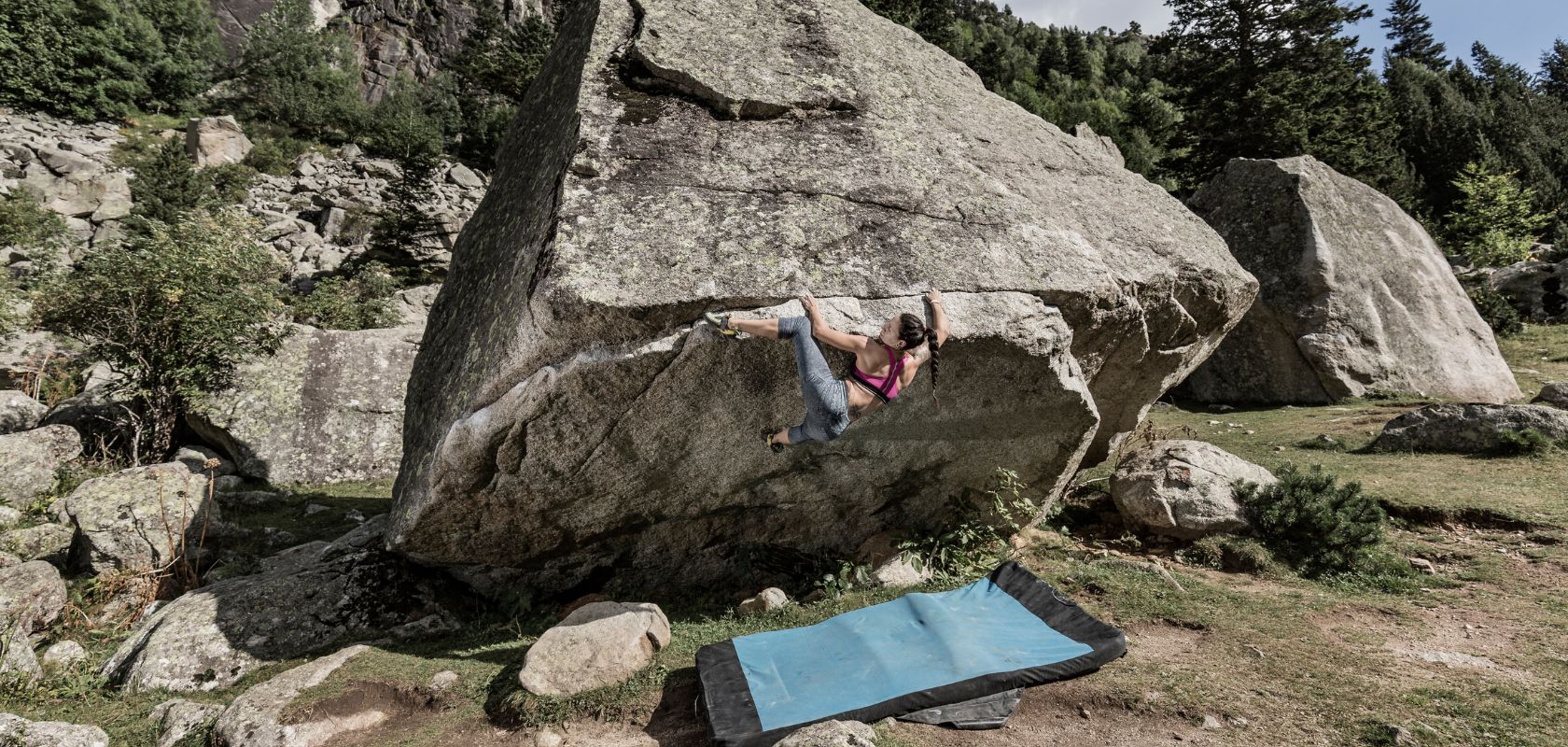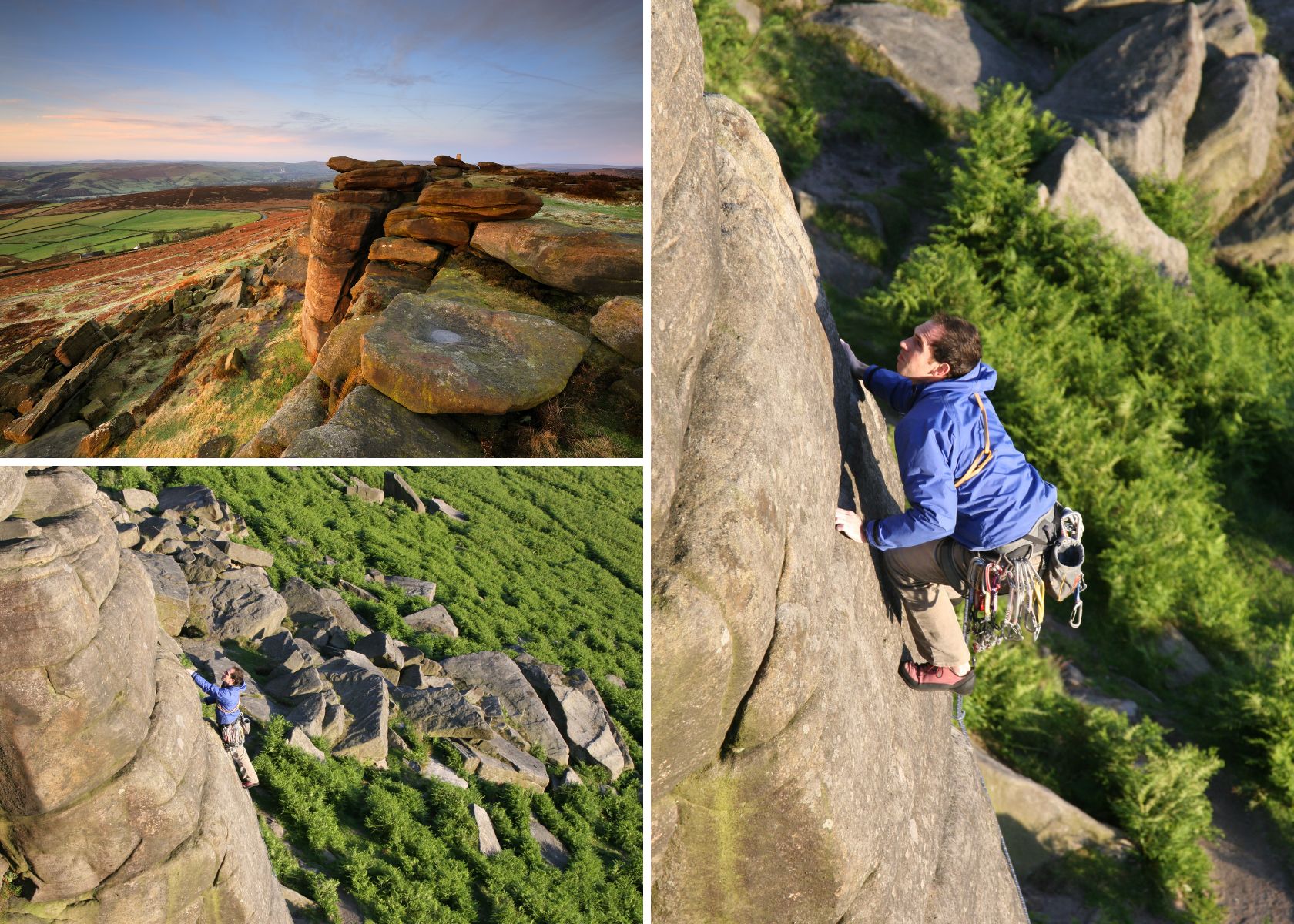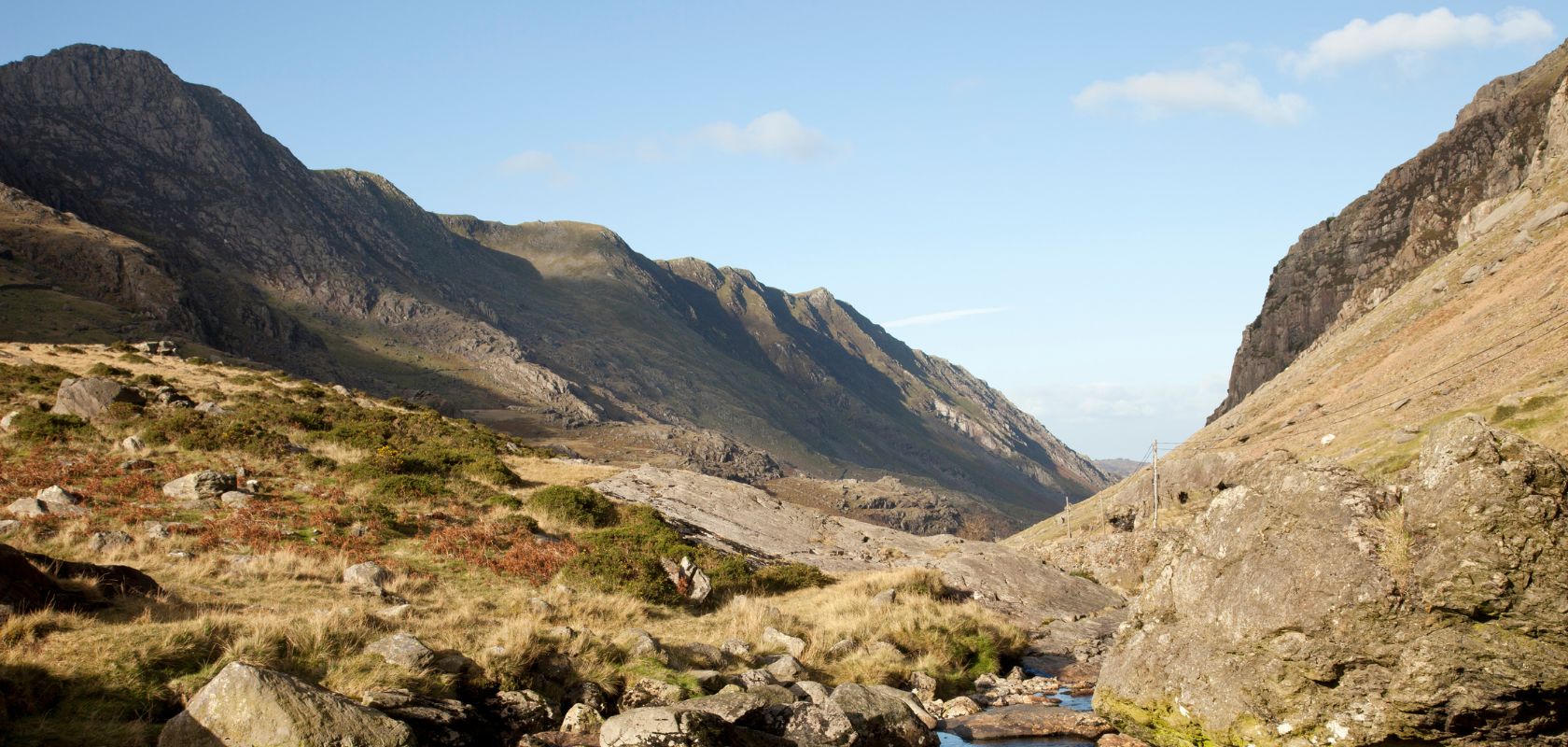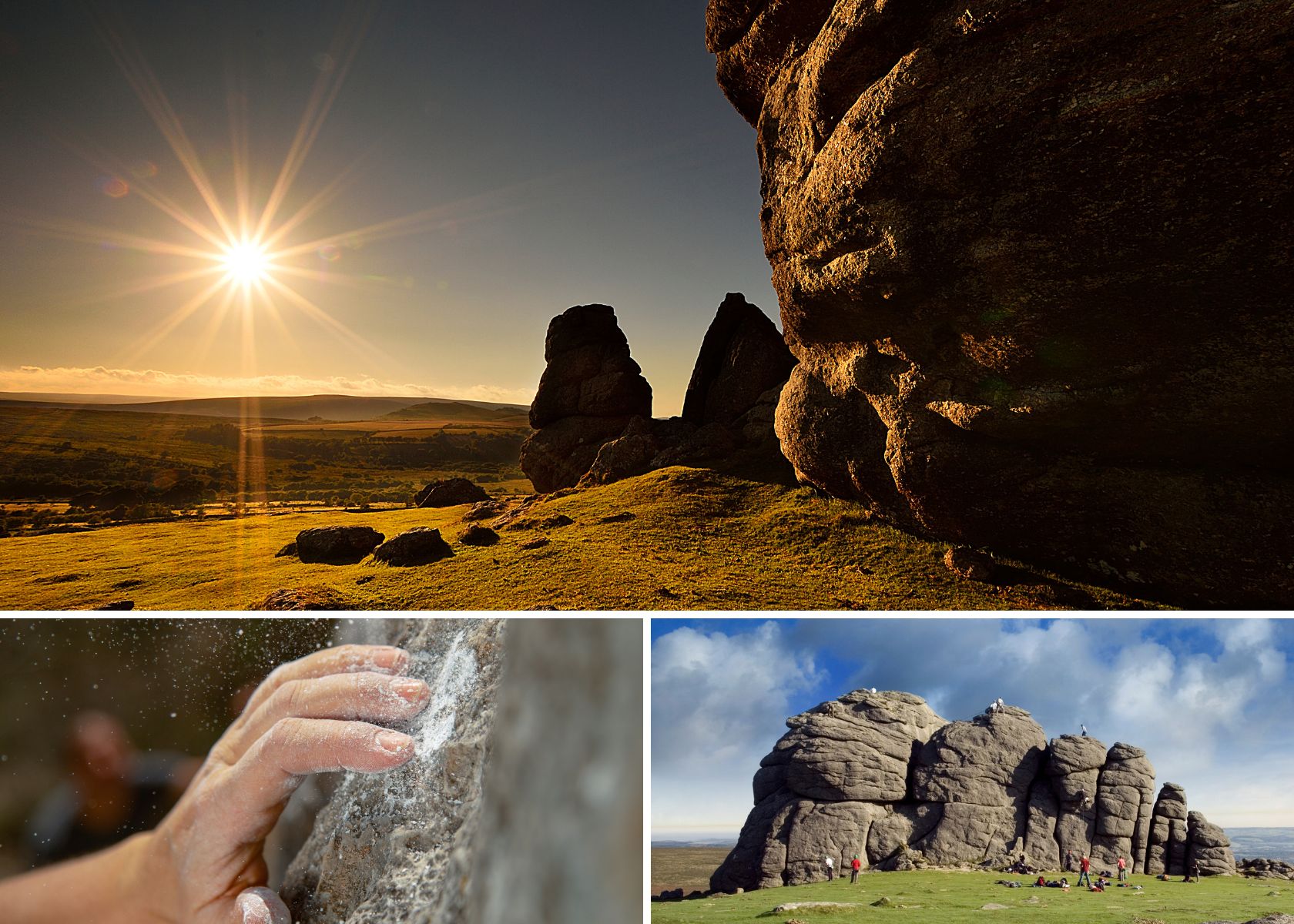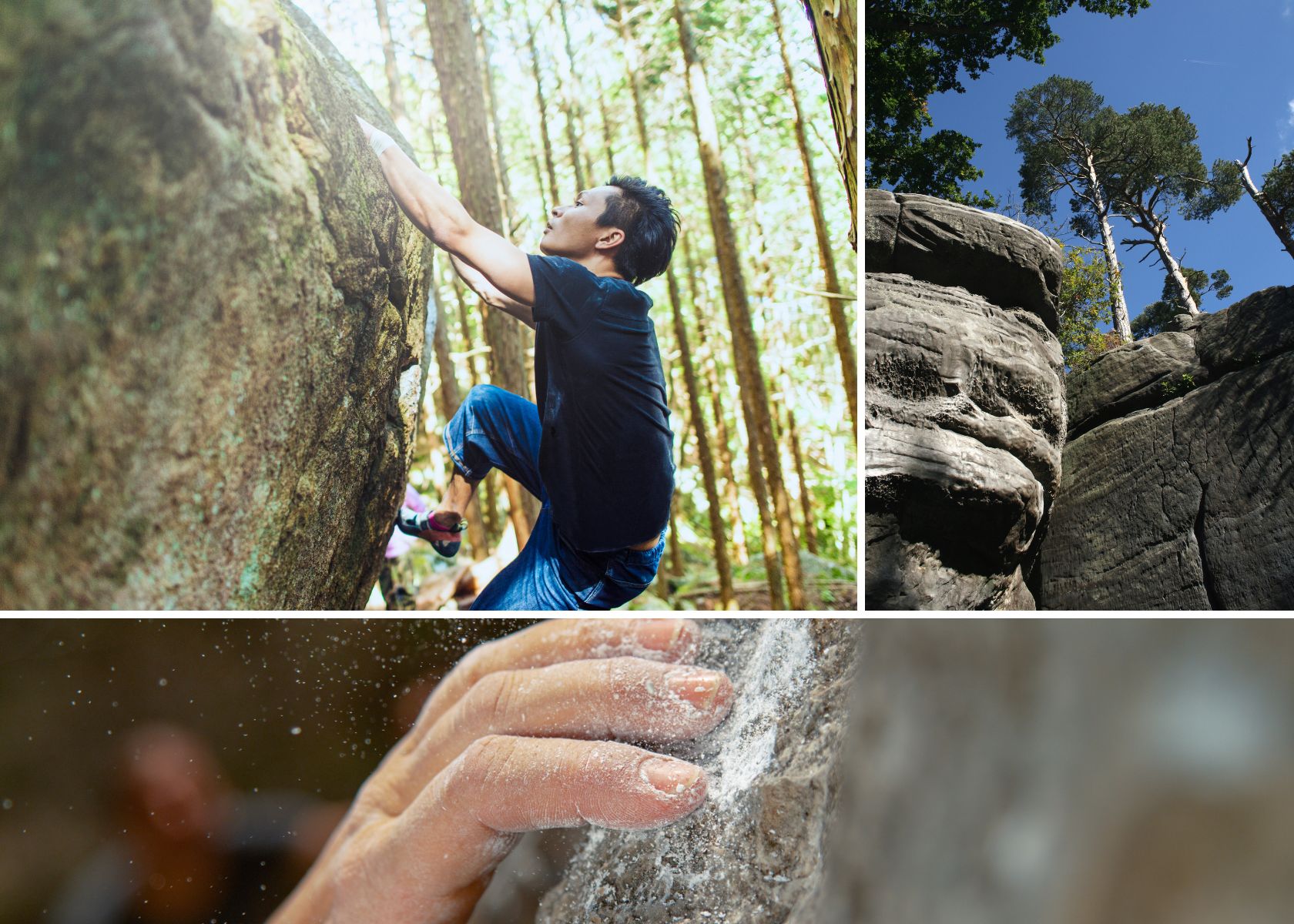5 GREAT BRITISH BOULDERING SPOTS
Ready to take your climbing skills outside? The UK has an abundance of great routes - or climbing "problems" - for you to do just that. Here's our pick of the top five bouldering spots Britain has to offer.
Stanage Edge, Peak District
Stanage Edge is widely regarded as one of England’s most iconic natural climbing venues—a true mecca for boulderers and trad climbers alike. This legendary gritstone escarpment stretches for nearly 7km across the Peak District, offering a staggering variety of bouldering and scrambling opportunities for all abilities. Whether you’re a beginner or a seasoned climber, you’ll find countless classic problems and hidden gems dotted along the edge and among the scattered boulders below.
The Plantation Area is especially renowned for its world-class bouldering, with the Grand Hotel Boulders, Central and Pebble Boulders, and a host of diverse problems along the main edge itself. The gritstone here is famous for its unique texture and friction, enabling technical moves and dynamic mantles that are unlike anything found on indoor walls. Stanage’s bouldering covers everything from delicate slabs and rounded arêtes to fierce overhangs and perfect cracks, ensuring there’s something for every style and grade.
Access and Practicalities:
- Location: On the outskirts of Sheffield, easily reached by bus, bike, or car.
- Parking: Limited—arrive early, especially on weekends, to secure a spot.
- Conditions: The crag faces southwest and dries quickly after rain, but friction is best on cool, dry days.
- Facilities: No amenities at the crag—bring everything you need and take all litter home.
Bouldering Highlights:
- Grand Hotel Boulders: Near Plantation Path, a cluster of problems for all grades.
- Central and Pebble Boulders: Offer a mix of classic lines and technical challenges.
- Problems along the Edge: The escarpment itself features a huge range of problems, from easy warm-ups to notorious testpieces.
Tips for Visiting Stanage Edge:
- Don’t expect your indoor climbing grade to transfer directly—gritstone demands technique, confidence, and adaptation to outdoor conditions.
- The weather can be fickle; always check the forecast and be prepared for rapid changes.
- Respect the landscape: park considerately, avoid blocking access for locals and farmers, and keep noise to a minimum.
- Stanage is popular, but with so much rock, it’s usually possible to find a quiet spot even on busy days.
Stanage Edge’s combination of volume, variety, and stunning Peak District scenery makes it a must-visit for any boulderer in Britain. Its legendary status is well-earned—come for the world-class problems, stay for the unbeatable atmosphere and views.
Llanberis Pass, Snowdonia
Llanberis Pass in Snowdonia is the epicentre of North Wales bouldering, set amidst dramatic mountain scenery and home to some of the most celebrated blocs in Britain. The valley’s rugged landscape is scattered with volcanic boulders, offering problems for every ability and style—from delicate slabs to steep power challenges. The area is famed for its high-quality rock, classic lines, and a unique social atmosphere that draws climbers from across the UK.
The Wavelength Boulders, perched on the slope behind the Ynys Ettws climbing hut, are the heart of the Pass’s bouldering scene. Here you’ll find the highest concentration of classic problems and iconic blocs, including the legendary Wavelength Boulder itself, renowned for both its beauty and the diversity of its climbs. For those seeking a more social or accessible session, the Cromlech Boulders sit right beside the road at Pont y Gromlech car park—arguably the ultimate in roadside bouldering, with problems that can be started almost from your car door.
Key features of Llanberis Pass bouldering:
- Location: In the heart of Snowdonia National Park, between the Glyderau and Snowdon massif.
- Bouldering areas:
- Wavelength Boulders: Highest concentration of classics, set on a scenic slope above the valley.
- Cromlech Boulders: Roadside, highly accessible, and perfect for a social bouldering meet.
- Rock type: Volcanic, with excellent friction and a wide variety of problems.
- Grades: Problems for all abilities, from beginner-friendly to testpieces.
- Access: Easy parking at Pont y Gromlech; both areas are short walks from the car park.
- Best conditions: Cool summer days or late autumn evenings; the valley can be exposed and windy in winter.
Practical tips:
- Outdoor bouldering carries extra risks compared to the gym: always use bouldering mats and learn how to fall safely.
- Practice spotting techniques indoors and on low problems before venturing onto higher blocs. Effective spotting means protecting the climber’s head and guiding them to the mat when they land.
- The Pass can get busy, especially at the Cromlech Boulders, but there’s always space to explore more secluded blocs up the hillside.
- Weather can change quickly—bring appropriate layers and check the forecast before heading out.
Llanberis Pass is more than just a climbing destination—it’s a legendary landscape, combining world-class bouldering, stunning mountain views, and a vibrant climbing community. Whether you’re chasing classic circuits or just enjoying a social session by the roadside, it’s a must-visit spot for any British boulderer.
Bonehill Rocks, Dartmoor
Bonehill Rocks is the spiritual home of Dartmoor bouldering and one of the UK’s most accessible and varied granite venues. Set amid the open, windswept uplands of Dartmoor National Park, Bonehill offers a vast array of over 100 bouldering problems—from easy scrambles and slabs to technical, powerful lines that challenge even seasoned climbers. The granite tors here are scattered across open moorland, just a short walk north of the car park, making it a perfect destination for both spontaneous sessions and planned days out.
The venue is renowned for its year-round climbing, thanks to Dartmoor’s relatively moderate climate compared to northern UK crags. The rock dries quickly, and the agreeable landings make it beginner-friendly while still offering plenty for advanced climbers, including classic testpieces like the Rippled Wall (V4), the Wave (V6), and the Left Arête of the Scoop (V7)—the latter often compared to the famous boulders of Fontainebleau.
Bouldering highlights at Bonehill Rocks:
- Trench Traverse (V1): A popular warm-up circuit for locals.
- Rippled Wall (V4): One of the most climbed and attempted problems in the area.
- The Wave (V6): A rite of passage for Dartmoor boulderers.
- Left Arête of the Scoop (V7): Technical and iconic, reminiscent of continental granite classics.
- Warm Up Slab (V0): Great for beginners and those new to outdoor bouldering.
Access and practicalities:
- Location: North of the car park near Widecombe-in-the-Moor; follow signs from Haytor, with the rocks visible from the road.
- Parking: Several parking areas (south, east, and north of the Tor) provide easy access, with just a 30-second walk to the boulders.
- Land status: Open access land under the Countryside & Rights of Way Act, with legal access for climbing, though occasional restrictions may apply for land management or safety.
- Atmosphere: Despite its popularity among climbers, Bonehill often feels peaceful and uncrowded, especially on weekdays or outside peak season.
Top tips for bouldering at Bonehill:
- Outdoor bouldering differs from the gym—“topping out” means standing on the highest point, not just matching the top hold. Many Dartmoor boulders have smooth, holdless tops, so practise topping out on low problems first.
- Always bring a bouldering mat for safety, and check the landings before you start.
- The granite is sharp with excellent friction, but can be tough on skin—bring tape and a brush for cleaning holds if needed.
- Check for any temporary access restrictions, especially during shooting seasons or conservation work.
Bonehill Rocks stands out for its sheer variety, easy access, and stunning Dartmoor views—a must-visit for anyone looking to experience the best of British granite bouldering, whether you’re a first-timer or chasing classic V-grades.
Southern Sandstone, East Sussex
Southern Sandstone in East Sussex is the go-to bouldering destination for London-based climbers, offering a wealth of sandstone outcrops within easy reach of the capital. While it may not carry the legendary status of some northern venues, its soft, fine-grained rock is a true test of technique, footwork, and core strength—many of the UK’s top climbers have honed their skills here. The area is especially valuable for those looking to improve their movement and precision, as the delicate holds and fragile rock punish sloppy climbing but reward careful, mindful technique.
Mount Edgcumbe Rocks is a standout bouldering venue, located on the north side of Tunbridge Wells Common and just a short walk from the train station. This area is dedicated to bouldering, with no fixed bolts, and is a favourite for its accessibility and quiet atmosphere. The sandstone here is particularly soft and sandy, so climbers must use extra care—gentle movement and clean shoes are essential to preserve the rock for future visitors. The best time to visit is early spring or autumn, as summer’s rampant vegetation can make access tricky.
Other major Southern Sandstone bouldering spots include:
- Harrison’s Rocks: The largest crag in the area, with over 350 climbs, including a huge range of boulder problems from F2 to F7C. Managed by the BMC, Harrison’s is always open to climbers and features a mix of solo and top-rope climbing.
- Stone Farm Rocks: Another BMC-owned venue, known for its quiet setting, over 140 climbs, and reliable bouldering.
- Bowles Rocks, High Rocks, Eridge Green Rocks: Additional outcrops, each with their own character and selection of problems, all within a short drive of each other.
Key points for bouldering on Southern Sandstone:
- Location: Borders of Kent and East Sussex, with the main outcrops near Tunbridge Wells and East Grinstead.
- Rock type: Soft, fine-grained sandstone—requires careful climbing to avoid erosion.
- Access: Most venues have parking nearby; some, like Mount Edgcumbe, are within walking distance of public transport.
- Climbing style: Pure bouldering and top-roping only—no leading or trad gear, due to the fragility of the rock.
- Grades: Wide range, with Font grades commonly used for bouldering.
- Best season: Early spring and autumn for best conditions and easier access.
- Facilities: Some crags, like Harrison’s, have toilets, parking, and even camping nearby.
Tips for your first visit:
- Always check and follow the local Code of Practice to protect the rock—use soft-soled shoes, clean your feet before climbing, and avoid climbing when the rock is wet.
- Plan your descent before you start: topping out can be tricky, and safe exits aren’t always obvious.
- Outdoor bouldering is about more than just climbing up—think about how you’ll get down, and always use mats and spotters for safety.
- Expect to find your weaknesses exposed: the sandstone’s subtle holds and sloping features are a masterclass in balance and technique.
Southern Sandstone is a historic and technical bouldering playground, perfect for those looking to refine their skills on real rock close to London. Its unique geology, accessibility, and variety make it a must-visit for any climber wanting to progress from the gym to the outdoors.
Dumbarton, Scotland
Dumbarton Rock—known affectionately as “Dumby”—is the undisputed home of Scottish bouldering and a legendary venue just a short journey from Glasgow. Set beneath the imposing basalt plug crowned by Dumbarton Castle, this post-industrial landscape has shaped generations of climbers and remains a proving ground for the country’s hardest problems and most dedicated boulderers.
The seven main basalt boulders and slabs at Dumby offer a huge range of problems, from accessible warm-ups to some of the most technical and powerful lines in the UK. The climbing is characterised by slopey, flat, and crimpy ledges on fine-grained basalt, demanding a blend of brute power, cunning technique, and precise footwork. The rock is generally skin-friendly, but friction can be limited during warmer months—climbers often seek out the overhanging or sheltered faces, which stay dry even in rain and dry quickly once the weather clears.
Dumby’s bouldering is famous for its accessible difficulty: while there are problems for all abilities, many lines feel hard for the grade, especially if you’re new to the style or used to indoor climbing. It’s a place that rewards patience, persistence, and beta-sharing with the local community. The venue is also known for its highballs and bold lines, so a good pad and spotting are essential.
Key features of Dumbarton Rock:
- Location: West of Glasgow, easily reached by train, car, or bike; set at the confluence of the Leven and Clyde rivers.
- Rock type: Fine-grained basalt—technical, skin-friendly, but can feel frictionless in the heat.
- Problems: Over 300 documented boulder problems, from easy circuits to 8th-grade testpieces like Pongo, Sabotage, Pressure, Sanction, and Gutbuster.
- Climbing style: Mix of powerful and technical moves on slopers, crimps, and highballs; requires both strength and finesse.
- Conditions: Climbing is possible year-round; overhangs and quick-drying rock make it a good bet even after rain.
- Atmosphere: Urban, eclectic, and historic, with a strong local scene and a sense of climbing heritage.
- Facilities: No amenities at the crag—bring all your own supplies and respect the site.
Tips for visiting Dumby:
- Clean your shoes before every attempt to protect the soft basalt and maximise friction—never chip the rock or use a wire brush; a stiff-bristled brush is best.
- Don’t be discouraged if problems feel tough at first—Dumby rewards persistence and learning local beta.
- Bring enough pads and spotters, especially for the higher problems.
- The area is family-friendly and has flat ground around the boulders, but be mindful of the urban setting and occasional litter.
Bonus: If you’re in Edinburgh, check out the South Quarry of Salisbury Crags for more urban bouldering options.
Dumbarton Rock is a must-visit for any serious boulderer—a place where Scottish climbing history meets modern progression, and where every session can leave you both humbled and inspired.
Gear Up for the Challenge
If you're planning to give any of these challenges a go, make sure you're geared up before you head out. At Snow+Rock, we stock a range of bouldering essentials, from climbing helmets to help keep you safe to clothing that maximises your movement, so you're sure to find what you need to get out there and have a gnarly time.
Related Articles

Let us know you agree to cookies
We use marketing, analytical and functional cookies as well as similar technologies to give you the best experience. Third parties, including social media platforms, often place tracking cookies on our site to show you personalised adverts outside of our website.
We store your cookie preferences for two years and you can edit your preferences via ‘manage cookies’ or through the cookie policy at the bottom of every page. For more information, please see our cookie policy.

